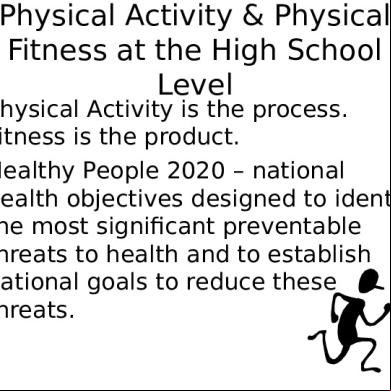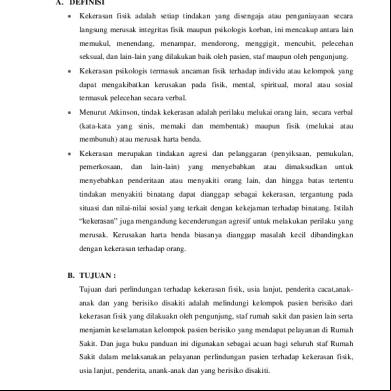Baecke Questionnaire For Measurement Of A Person's Habitual Physical Activity 6f6m51
This document was ed by and they confirmed that they have the permission to share it. If you are author or own the copyright of this book, please report to us by using this report form. Report 3b7i
Overview 3e4r5l
& View Baecke Questionnaire For Measurement Of A Person's Habitual Physical Activity as PDF for free.
More details w3441
- Words: 778
- Pages: 6
The Questionnaire of Baecke et al for Measurement of a Person's Habitual Physical Activity Overview: Baecke et al developed a questionnaire for evaluating a person's physical activity and separating it into three distinct dimensions. The authors were from the Netherlands. Indices for physical activity: (1) work activity (2) sports activity (3) leisure activity Work Index Question
Response
Points
What is your main occupation?
low activity
1
moderate activity
3
high activity
5
never
1
seldom
2
sometimes
3
often
4
always
5
never
1
seldom
2
sometimes
3
often
4
always
5
never
1
seldom
2
sometimes
3
often
4
always
5
At work I sit
At work I stand
At work I walk
At work I lift heavy loads
After working I am tired
At work I sweat
In comparison of others of my own age I think my work is physically
never
1
seldom
2
sometimes
3
often
4
always
5
very often
5
often
4
sometimes
3
seldom
2
never
1
very often
5
often
4
sometimes
3
seldom
2
never
1
much heavier
5
heavier
4
as heavy
3
lighter
2
much lighter
1
where: • The work activity is according to the Netherlands Nutrition Council with (1) low activity including clerical work driving shopkeeping teaching studying housework medical practice and occupations requiring a university education; (2) middle activity including factory work plumbing carpentry and farming; (3) high activity includes dock work construction work and professional sport. work index = ((6 – (points for sitting)) + SUM(points for the other 7 parameters)) / 8
Sport Index Question
Response
Do you play sports?
yes then calculate sport score
In comparison with others of my own age I think my physical activity during leisure time is
During leisure time I sweat
During leisure time I play sport
Points (see below)
• sport score >= 12
5
• sport score 8 to < 12
4
• sport score 4 to < 8
3
• sport score 0.01 to < 4
2
• sport score = 0
1
No
1
much more
5
More
4
the same
3
Less
2
much less
1
very often
5
Often
4
sometimes
3
Seldom
2
Never
1
Never
1
Seldom
2
sometimes
3
Often
4
very often
5
Data on Most Frequently Played Sport
Finding
What sport do yo play most frequently
low intensity
0.76
medium intensity
1.26
high intensity
1.76
< 1 hour
0.5
1-2 hours
1.5
2-3 hours
2.5
3-4 hours
3.5
> 4 hours
4.5
< 1 month
0.04
1-3 months
0.17
4-6 months
0.42
7-9 months
0.67
> 9 months
0.92
How many hours do you play a week?
How many months do you play in a year?
Value
where: • The sport intensity is divided into 3 levels: (1) low level (billiards sailing bowling golf etc) with an average energy expenditure of 0.76 MK/h; (2) middle level (bton cycling dancing swimming tennis) with an average energy expenditure of 1.26 MJ/h; (3) high level (boxing basketball football rugby rowing) with an average energy expenditure of 1.76 MJ/h
Data on Second Most Frequently Played Sport
Finding
What sport do you play most frequently
low intensity
0.76
medium intensity
1.26
high intensity
1.76
< 1 hour
0.5
1-2 hours
1.5
2-3 hours
2.5
3-4 hours
3.5
> 4 hours
4.5
< 1 month
0.04
1-3 months
0.17
4-6 months
0.42
7-9 months
0.67
> 9 months
0.92
How many hours do you play a week?
How many months do you play in a year?
Value
simple sports score = ((value for intensity of most frequent sport) * (value for weekly time of most frequent sport) * (value for yearly proportion of most frequent sport)) * ((value for intensity of second sport) * (value for weekly time of second sport) * (value for yearly proportion of second sport)) sport index = (SUM(points for all 4 parameters)) / 4
Leisure Index Question
Response
During leisure time I watch television
never
1
seldom
2
sometimes
3
often
4
very often
5
never
1
seldom
2
sometimes
3
often
4
very often
5
never
1
seldom
2
sometimes
3
often
4
very often
5
< 5 minutes
1
5-15 minutes
2
15-30 minutes
3
30-45 minutes
4
> 45 minutes
5
During leisure time I walk
During leisure time I cycle
How many minutes do you walk and/or cycle per day to and from work school and shopping?
Points
leisure index = ((6 – (points for television watching)) + SUM(points for remaining 3 items)) / 4 References: Baecke JAH Burema J Frijters ER. A short questionnaire for the measurement of habitual physical activity in epidemiological studies. Am J Clin Nutr. 1982; 36: 936-942.
Response
Points
What is your main occupation?
low activity
1
moderate activity
3
high activity
5
never
1
seldom
2
sometimes
3
often
4
always
5
never
1
seldom
2
sometimes
3
often
4
always
5
never
1
seldom
2
sometimes
3
often
4
always
5
At work I sit
At work I stand
At work I walk
At work I lift heavy loads
After working I am tired
At work I sweat
In comparison of others of my own age I think my work is physically
never
1
seldom
2
sometimes
3
often
4
always
5
very often
5
often
4
sometimes
3
seldom
2
never
1
very often
5
often
4
sometimes
3
seldom
2
never
1
much heavier
5
heavier
4
as heavy
3
lighter
2
much lighter
1
where: • The work activity is according to the Netherlands Nutrition Council with (1) low activity including clerical work driving shopkeeping teaching studying housework medical practice and occupations requiring a university education; (2) middle activity including factory work plumbing carpentry and farming; (3) high activity includes dock work construction work and professional sport. work index = ((6 – (points for sitting)) + SUM(points for the other 7 parameters)) / 8
Sport Index Question
Response
Do you play sports?
yes then calculate sport score
In comparison with others of my own age I think my physical activity during leisure time is
During leisure time I sweat
During leisure time I play sport
Points (see below)
• sport score >= 12
5
• sport score 8 to < 12
4
• sport score 4 to < 8
3
• sport score 0.01 to < 4
2
• sport score = 0
1
No
1
much more
5
More
4
the same
3
Less
2
much less
1
very often
5
Often
4
sometimes
3
Seldom
2
Never
1
Never
1
Seldom
2
sometimes
3
Often
4
very often
5
Data on Most Frequently Played Sport
Finding
What sport do yo play most frequently
low intensity
0.76
medium intensity
1.26
high intensity
1.76
< 1 hour
0.5
1-2 hours
1.5
2-3 hours
2.5
3-4 hours
3.5
> 4 hours
4.5
< 1 month
0.04
1-3 months
0.17
4-6 months
0.42
7-9 months
0.67
> 9 months
0.92
How many hours do you play a week?
How many months do you play in a year?
Value
where: • The sport intensity is divided into 3 levels: (1) low level (billiards sailing bowling golf etc) with an average energy expenditure of 0.76 MK/h; (2) middle level (bton cycling dancing swimming tennis) with an average energy expenditure of 1.26 MJ/h; (3) high level (boxing basketball football rugby rowing) with an average energy expenditure of 1.76 MJ/h
Data on Second Most Frequently Played Sport
Finding
What sport do you play most frequently
low intensity
0.76
medium intensity
1.26
high intensity
1.76
< 1 hour
0.5
1-2 hours
1.5
2-3 hours
2.5
3-4 hours
3.5
> 4 hours
4.5
< 1 month
0.04
1-3 months
0.17
4-6 months
0.42
7-9 months
0.67
> 9 months
0.92
How many hours do you play a week?
How many months do you play in a year?
Value
simple sports score = ((value for intensity of most frequent sport) * (value for weekly time of most frequent sport) * (value for yearly proportion of most frequent sport)) * ((value for intensity of second sport) * (value for weekly time of second sport) * (value for yearly proportion of second sport)) sport index = (SUM(points for all 4 parameters)) / 4
Leisure Index Question
Response
During leisure time I watch television
never
1
seldom
2
sometimes
3
often
4
very often
5
never
1
seldom
2
sometimes
3
often
4
very often
5
never
1
seldom
2
sometimes
3
often
4
very often
5
< 5 minutes
1
5-15 minutes
2
15-30 minutes
3
30-45 minutes
4
> 45 minutes
5
During leisure time I walk
During leisure time I cycle
How many minutes do you walk and/or cycle per day to and from work school and shopping?
Points
leisure index = ((6 – (points for television watching)) + SUM(points for remaining 3 items)) / 4 References: Baecke JAH Burema J Frijters ER. A short questionnaire for the measurement of habitual physical activity in epidemiological studies. Am J Clin Nutr. 1982; 36: 936-942.










